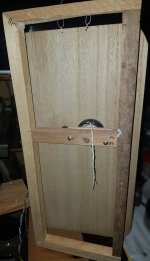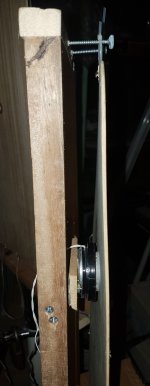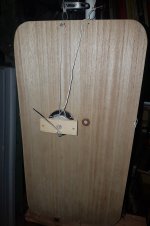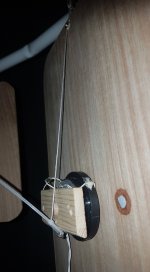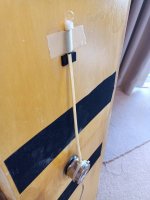Hello. This idea sounds interesting to me too as we are looking for light and stiff but not too stiff material. Not seen for now as far as remember (this thread is more than vast)Has anyone explored sandwiching dissimilar materials? I mention that because one study suggested poplar ply was great for certain frequencies and EPS was good for the other. Perhaps combining both into one non-uniform panel (one layer a different size shape than the other)? Or perhaps just sandwiching the same material?
Hello; Most of the frames are from wood or similar because of the availability of the components in the DIY store, the tooling, the damping, the style... why something else? Square aluminium tube used for shelves fill with sand? I think such kits are available in DIY store. The tubes have to be adjusted in length; plastic parts make the connection. I thought also to make something with PVC water pipes also filled with sand at least for the vertical members and wood for the top and bottom members. This technique might be a good option if the membrane is attached only on the vertical long side as Burnt did in the snow white, with the suspension glued on the membrane side as recommended in an other thread (TE). The reason of sand is it is a good vibration stopper.Hello everybody
I recently bought a carbon and nomex panel about the size of the tectonic ones, unfortunately I still can't test everything well, I would like to create a frame to support the panel and the exciters but I don't know what material to use as an alternative to wood or iron, the aim at the moment is to create a structure that is stable without great expense.
Tips?
thank you
Don't forget the capacitance (in µF) of those exciters (see the PA DML thread)... probably not suitable in words of stability for all the amplifiers.And from 2013
An other key point is what is the FR when the panel is driven on quite large surface. The theory covers the case of a driving point. In reallity we drive on a circle line (the voice coil) that defines 2 areas (inner and outer) with 2 different behavior. A patent I mentioned before suggest to increase this diameter. Here, it is a third type.
I didn't try sandwiching, but a small square of bly glue on a middle size EPS just like the canvas panel.Has anyone explored sandwiching dissimilar materials? I mention that because one study suggested poplar ply was great for certain frequencies and EPS was good for the other. Perhaps combining both into one non-uniform panel (one layer a different size shape than the other)? Or perhaps just sandwiching the same material?
I don't remember what it sounds like, but quite sure it's not a good result because I never did it again.
Last weekend I finally tried the spine + hanging frame (pic1).
It quite easy to made, actually we don't need the lower part of the frame. Just the upper square is enough. But of course you have to find a way to mount, hang or sit the frame.
A piece of wood was glue to the exciter back (pic3). I used a bolt system to attached the exciter to the frame (pic2). It give me chance to remove the exciter easy.
Because the panel is just hanging on the frame. The panel is a free float, and will not cause pressure on the exciter. However the height and position of the exciter must match the spine accurately. I used zip-tie on the hanging cords for fine tune.
I'm satisfy the result. The exciter no more head-down by gravity so that's no voice coil noise on some particular HZ. And the free flow panel don't get damped, sound still lively.
Edition 2
After finished the frame method. I just think maybe a more easy way can hold the exciter without a fix spine. So I tried the tug cord method (pic3+4).
Also I zip-tie to fine tune the cord length. The anchor is a screw next to the panel hanging point. So I think it may not increase the damping on the panel much. Or should I move the anchor outside the panel? On the hanging cord maybe?
It quite easy to made, actually we don't need the lower part of the frame. Just the upper square is enough. But of course you have to find a way to mount, hang or sit the frame.
A piece of wood was glue to the exciter back (pic3). I used a bolt system to attached the exciter to the frame (pic2). It give me chance to remove the exciter easy.
Because the panel is just hanging on the frame. The panel is a free float, and will not cause pressure on the exciter. However the height and position of the exciter must match the spine accurately. I used zip-tie on the hanging cords for fine tune.
I'm satisfy the result. The exciter no more head-down by gravity so that's no voice coil noise on some particular HZ. And the free flow panel don't get damped, sound still lively.
Edition 2
After finished the frame method. I just think maybe a more easy way can hold the exciter without a fix spine. So I tried the tug cord method (pic3+4).
Also I zip-tie to fine tune the cord length. The anchor is a screw next to the panel hanging point. So I think it may not increase the damping on the panel much. Or should I move the anchor outside the panel? On the hanging cord maybe?
Attachments
History file 13rd ed
Hello, please find with this link the History file 13rd ed.
Include Snow White and other posts.
Christian
Hello, please find with this link the History file 13rd ed.
Include Snow White and other posts.
Christian
SteveEucy.
I remember these piezoelectric videos , I was hoping things would have moved on over time .
High power piezoelectric drivers would be very interesting.
Steve.
Still seems to be the realm of small devices and limited to about 400 hz and up
Ziggy was enthusiastic though.
Eucy
Somewhere not too far back I posted pics of my most recent support method using zip ties - works wellLast weekend I finally tried the spine + hanging frame (pic1).
It quite easy to made, actually we don't need the lower part of the frame. Just the upper square is enough. But of course you have to find a way to mount, hang or sit the frame.
A piece of wood was glue to the exciter back (pic3). I used a bolt system to attached the exciter to the frame (pic2). It give me chance to remove the exciter easy.
Because the panel is just hanging on the frame. The panel is a free float, and will not cause pressure on the exciter. However the height and position of the exciter must match the spine accurately. I used zip-tie on the hanging cords for fine tune.
I'm satisfy the result. The exciter no more head-down by gravity so that's no voice coil noise on some particular HZ. And the free flow panel don't get damped, sound still lively.
Edition 2
After finished the frame method. I just think maybe a more easy way can hold the exciter without a fix spine. So I tried the tug cord method (pic3+4).
Also I zip-tie to fine tune the cord length. The anchor is a screw next to the panel hanging point. So I think it may not increase the damping on the panel much. Or should I move the anchor outside the panel? On the hanging cord maybe?
I found a copy - attached - the top end of the zip tie is glued to and separated from the panel by felt pads. The strip of masking tape is at the top was just to hold it until the glue dried - I just left it there. I also wrapped the tie with masking tape for damping (I love masking tape). A loop was formed at the the bottom through which was passed the second tie which is fixed tot he exciter - silicone was dobbed at the junction of the two ties
Of course the method used has to suit the exciter shape
Eucy
Eucy
Attachments
Last edited:
Hi Eucy how the DAEX25SHF sounds compare to other exciter?Somewhere not too far back I posted pics of my most recent support method using zip ties - works well
I found a copy - attached - the top end of the zip tie is glued to and separated from the panel by felt pads. The strip of masking tape is at the top was just to hold it until the glue dried - I just left it there. I also wrapped the tie with masking tape for damping (I love masking tape). A loop was formed at the the bottom through which was passed the second tie which is fixed tot he exciter - silicone was dobbed at the junction of the two ties
Of course the method used has to suit the exciter shape
Eucy
Eucy
Hkguy6.
My original 2mm corrected cardboard and aluminium panels over on my NXT RUBBISH days, used similar short term mountings to support the magnet weight.
This prevented the exciter weight from warping and bending the thin panel material around the coil foot.
I simply used 1inch masking tape from the top of the panel to the exciter magnet and used foam on the tape to stop the tape buzzing.
But this method does not prevent exciter wobble at low frequencies.
It is still out of balance, even the tape makes it more out of balance.
I noticed in pic 2 that there is a considerable warp in your panel, this could be a serious problem if rigid mounting was used on a ply panel, I mentioned this problem on, dml/open baffle for pro sound use, and a possible solution?
I should have mentioned this problem as another form of exciter noise and distress !
One rigid ply panel I put aside for quite a few months, had warped away from the exciter so badly that it had pulled away the spider from the magnet !
In the tectonic patent I believe they even mention panel wobble as being a serious problem for the exciters and methods used to prevent this.
I also notices some wires going under the exciter mounting in pic 4?
I did not intended this post to be so long.
Apologies.
Steve.
My original 2mm corrected cardboard and aluminium panels over on my NXT RUBBISH days, used similar short term mountings to support the magnet weight.
This prevented the exciter weight from warping and bending the thin panel material around the coil foot.
I simply used 1inch masking tape from the top of the panel to the exciter magnet and used foam on the tape to stop the tape buzzing.
But this method does not prevent exciter wobble at low frequencies.
It is still out of balance, even the tape makes it more out of balance.
I noticed in pic 2 that there is a considerable warp in your panel, this could be a serious problem if rigid mounting was used on a ply panel, I mentioned this problem on, dml/open baffle for pro sound use, and a possible solution?
I should have mentioned this problem as another form of exciter noise and distress !
One rigid ply panel I put aside for quite a few months, had warped away from the exciter so badly that it had pulled away the spider from the magnet !
In the tectonic patent I believe they even mention panel wobble as being a serious problem for the exciters and methods used to prevent this.
I also notices some wires going under the exciter mounting in pic 4?
I did not intended this post to be so long.
Apologies.
Steve.
Yes Steve the ply used in those pic has warp. It's because the high humidity here. For free hanging it's not a problem. That's why I keep the free hanging method on this spine-frame.Hkguy6.
My original 2mm corrected cardboard and aluminium panels over on my NXT RUBBISH days, used similar short term mountings to support the magnet weight.
This prevented the exciter weight from warping and bending the thin panel material around the coil foot.
I simply used 1inch masking tape from the top of the panel to the exciter magnet and used foam on the tape to stop the tape buzzing.
But this method does not prevent exciter wobble at low frequencies.
It is still out of balance, even the tape makes it more out of balance.
I noticed in pic 2 that there is a considerable warp in your panel, this could be a serious problem if rigid mounting was used on a ply panel, I mentioned this problem on, dml/open baffle for pro sound use, and a possible solution?
I should have mentioned this problem as another form of exciter noise and distress !
One rigid ply panel I put aside for quite a few months, had warped away from the exciter so badly that it had pulled away the spider from the magnet !
In the tectonic patent I believe they even mention panel wobble as being a serious problem for the exciters and methods used to prevent this.
I also notices some wires going under the exciter mounting in pic 4?
I did not intended this post to be so long.
Apologies.
Steve.
The tug cord method mainly for get rid of the noise at particular HZ.
This ply with the PUI exciter has noise at 228-233HZ and 440-445HZ these 2 range. Outside these range it's all fine.
The LF wobble just happen on my DAEX25FHE which I think it definitely need a fix spine. Or maybe a rigid mount panel also necessary.
The wires under in pic4 actually is the extension +/- wires from the voice coil (pic3 I lay those wires on top). This exciter originally is a DAEX58FP with square back.
I like these a lot... They were my first exciter purchase and I've since bought more.Hi Eucy how the DAEX25SHF sounds compare to other exciter?
At 25w, they pack a punch not equalled by the 40w Thruster (and they'll take more than the rated power without flinching). They're built like a brick, and in reference to the issue of wobble mentioned above, these are as steady as a Wankel rotary engine.
The Thruster I'm not so keen on... Can't put my finger on it but the highs don't seem as clean, and I think it may be related to the bigger voice coil diameter.
The closest one to the Rolls Royce DAEX25SHF (imo), is the DAEX30HESF4, and it's about half the price of the 25SHF, so it's good value. If be happy to use this in future panels.
For smaller panels, the DAEX25FHE4 seems ok, but for 24w compared with 25w for the 25SHF, it is out of its league. It is a far cheaper exciter however so as always, you get what you pay for.
Disclaimer: There are many more exciters available that I haven't tried than those I've tried, and all the above is of course totally subjective.
Cheers
Eucy
HelloYes Steve the ply used in those pic has warp. It's because the high humidity here. For free hanging it's not a problem. That's why I keep the free hanging method on this spine-frame.
The tug cord method mainly for get rid of the noise at particular HZ.
This ply with the PUI exciter has noise at 228-233HZ and 440-445HZ these 2 range. Outside these range it's all fine.
The LF wobble just happen on my DAEX25FHE which I think it definitely need a fix spine. Or maybe a rigid mount panel also necessary.
The wires under in pic4 actually is the extension +/- wires from the voice coil (pic3 I lay those wires on top). This exciter originally is a DAEX58FP with square back.
I don't know the humidity is in the different areas of the world, I guess north part of France is not very different from England, Honk Kong knows probably more humidity ? Seems from the graph below the difference is more in temperature ?
Any way, my plywood panels have now one year. They are finished with a light varnish on both side with a foam surrounding. The panel had a warp before to be glued on the foam but the glue and the foam did the job and they are still flat. To be cautious, a periodic control of the distance panel/spine near the exciter might be a good idea.
London vs Paris
Hong Kong
Hong Kong here can be VERY wet. We call it "回南天"。Hello
I don't know the humidity is in the different areas of the world, I guess north part of France is not very different from England, Honk Kong knows probably more humidity ? Seems from the graph below the difference is more in temperature ?
Any way, my plywood panels have now one year. They are finished with a light varnish on both side with a foam surrounding. The panel had a warp before to be glued on the foam but the glue and the foam did the job and they are still flat. To be cautious, a periodic control of the distance panel/spine near the exciter might be a good idea.
London vs Paris
View attachment 1101469 View attachment 1101471
Hong Kong
View attachment 1101470
I didn't read the % but on the wet days. My house the walls goes sweat, some bad days the ceiling has dropping!
Check this scene to see how funny serious it is: 回南天
Drops on the ceiling... yes very wet! I understand wood is perhaps not the best choice for you...Hong Kong here can be VERY wet. We call it "回南天"。
I didn't read the % but on the wet days. My house the walls goes sweat, some bad days the ceiling has dropping!
Check this scene to see how funny serious it is: 回南天
DML efficiency paper
Hello, I wrote down in a pdf the results I shared here about measurements of the efficiency of DML according to the material. Please find it this link : DMLefficiency.pdf.
Hello, I wrote down in a pdf the results I shared here about measurements of the efficiency of DML according to the material. Please find it this link : DMLefficiency.pdf.
Yep.... There's definitely a difference between European humidity and Asian/Tropical/SubTropical humidityDrops on the ceiling... yes very wet! I understand wood is perhaps not the best choice for you...
The effect is due to the higher temperatures .
In London/Paris it's rain, in Asia and down to northern Australia it's like steam
Eucy
Over on NXT RUBBISH, I did try to use EPS and a thin aluminium sheet to combine the two sounds.Has anyone explored sandwiching dissimilar materials? I mention that because one study suggested poplar ply was great for certain frequencies and EPS was good for the other. Perhaps combining both into one non-uniform panel (one layer a different size shape than the other)? Or perhaps just sandwiching the same material?
But basically I managed to create an over damped aluminium panel.
EPS looses all its qualities when glued to another material, and just becomes a damping layer.
Glueing two sheets of veneer, card, or aluminium seems to work well.
Coating XPS in in a thin coat of epoxy also seems a good idea.
There are many combinations, some work and some do not .
Steve.
Having visited and worked in Shanghai and Guangzhou and visited Bangkok I can confirm humidity in Asia is astonishing, and nothing like we experience in Europe. I was also struck by the regularity of the afternoon thunderstorm in Singapore. It hardly failed the time I was there. If I built a DML for use in the south I would definitely consider coating any plywood panels to protect them.Yep.... There's definitely a difference between European humidity and Asian/Tropical/SubTropical humidity
The effect is due to the higher temperatures .
In London/Paris it's rain, in Asia and down to northern Australia it's like steam
Eucy
Burnt
- Home
- Loudspeakers
- Full Range
- A Study of DMLs as a Full Range Speaker
